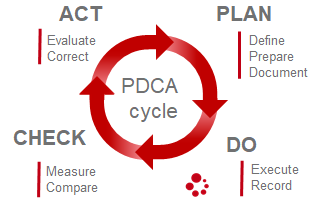Use PDCA-cycles to achieve continuous improvement in ITAM
Management processes provide a foundation on which specific ITAM processes can be defined. This so-called Management System follows the ISO structure, called High Level Structure (HLS).
TIP #9 - September 2019: Continuous improvement yields a higher amount of trustworthy data, less (compliance) risks, lower IT costs and a more efficient ITAM.
Next to the ISO19770-1 standard for ITAM, other ISO standards apply to this HLS as well, thus providing a common ‘language’ between various disciplines. This makes it easier to integrate ITAM processes with other ISO processes.
Management processes are constructed according to the well-known 'plan-do-check-act' (PDCA) method. An iterative, four-stage approach for continually improving processes, products or services, and resolving issues.
The four stages of the PDCA-cycle include:
- Plan - Determine improvements based on identified opportunities and risks, set objectives and prepare a program for implementation. The basis of an ITAM management system includes a good understanding of risks and possibilities for improving activities, products or services.
- Do - Take organisational and technical measures to achieve ITAM objectives.
- Check - Monitor whether objectives are being achieved and risks are safeguarded, and, where necessary, take corrective measures.
- Act - Adapt the change aimed at further improvement of performance.

Figure 1. Illustration of the 4 stages in the PDCA cycle
Especially for improvement initiatives the PDCA is a continuous cycle. Once a total cycle is executed, more value is created through the implemented improvements. Value in this perspective includes a higher amount of trustworthy data, less (compliance) risks, lower cost of IT assets and a more efficient ITAM operation.
A successful improvement needs to be secured and embedded within the organisation in a solid way. Together with further improvements, this must be part of the next PDCA cycle.
Figure 2. Continuous improvement with the PDCA cycle
ITAM Strategic and Operation cycle

Figure 3. The interaction between the Strategic and Operation PDCA cycle
For ITAM, two different PDCA cycles are applicable: a Strategic cycle and an Operation cycle. The Strategic cycle is used to align with the organisational objectives, set the direction for ITAM in a strategic plan and drive the execution of the strategy. The strategy execution - the Operation cycle - is a PDCA cycle on its own. This Operation cycle is feeding, through the Check stage, the Strategic cycle.
Management processes apply to both the Strategic and the Operational PDCA cycle. Specific ITAM processes that can be identified will all relate to the DO stage of the Operational PDCA cycle. By keeping both PDCA-cycles in mind and maintaining all stages, continuous improvements regarding your ITAM implementation can be achieved, secured and embedded.